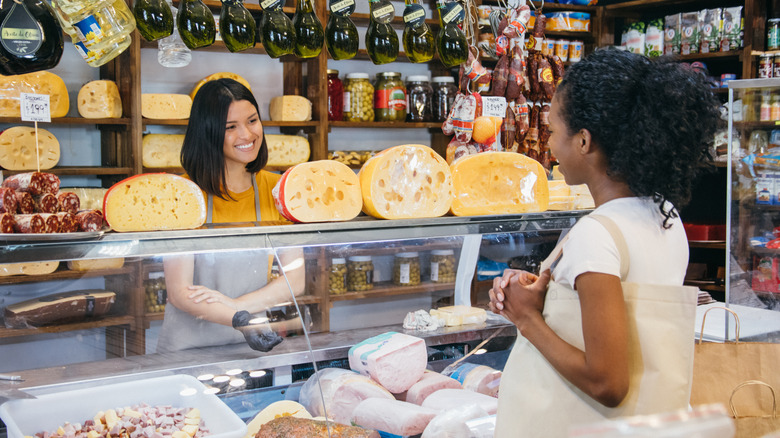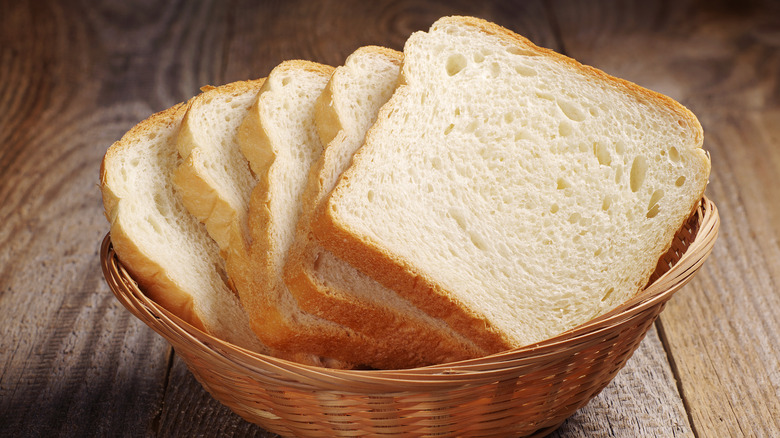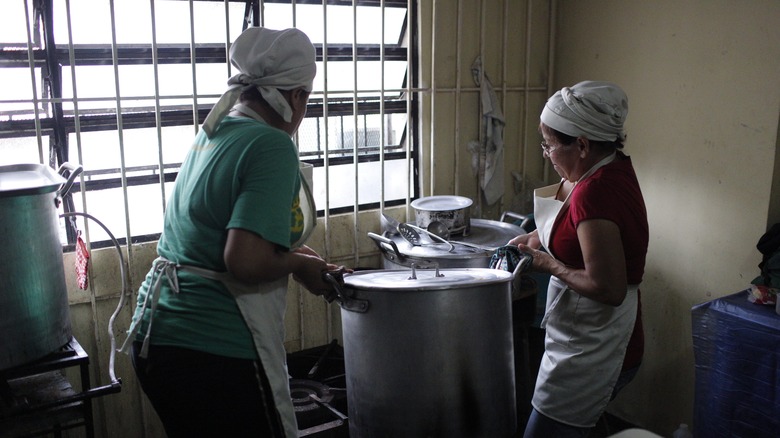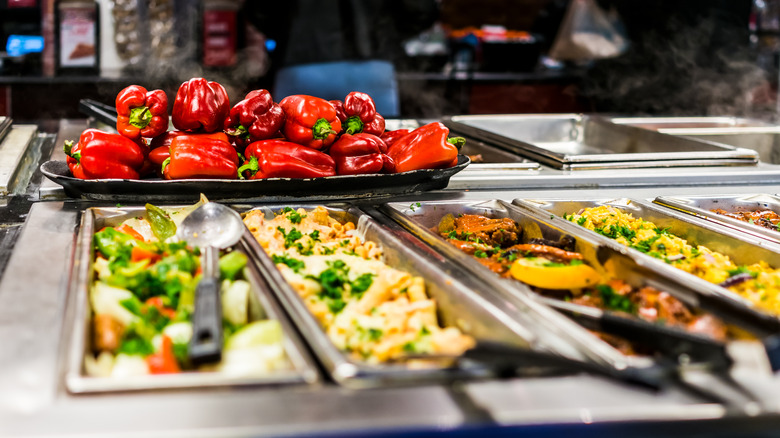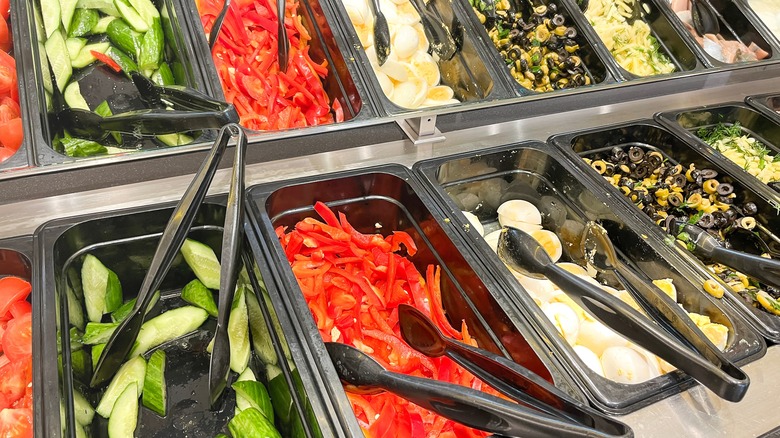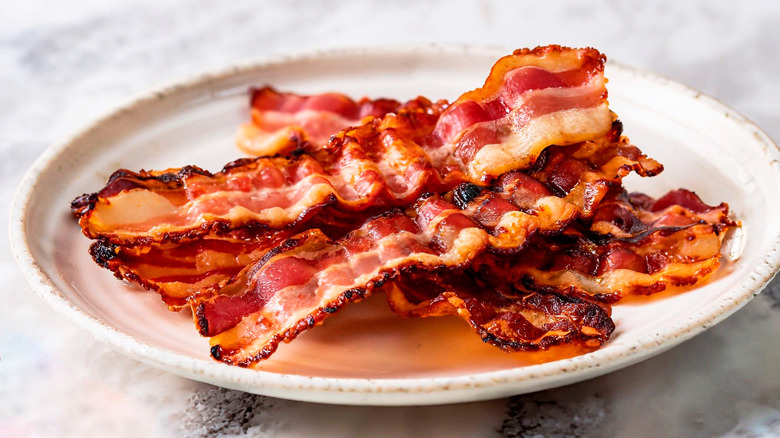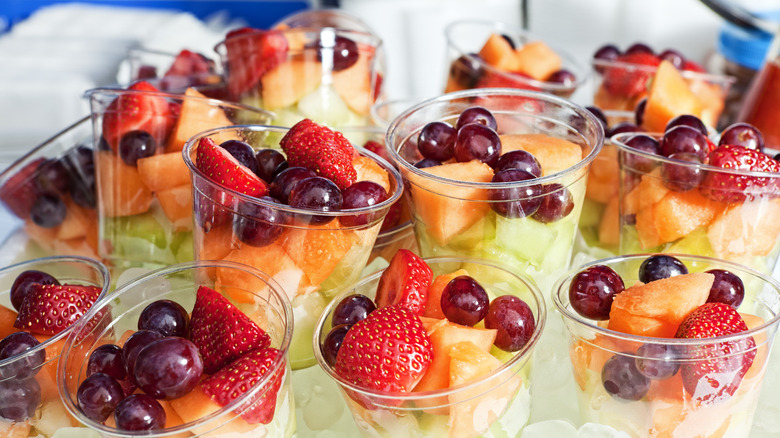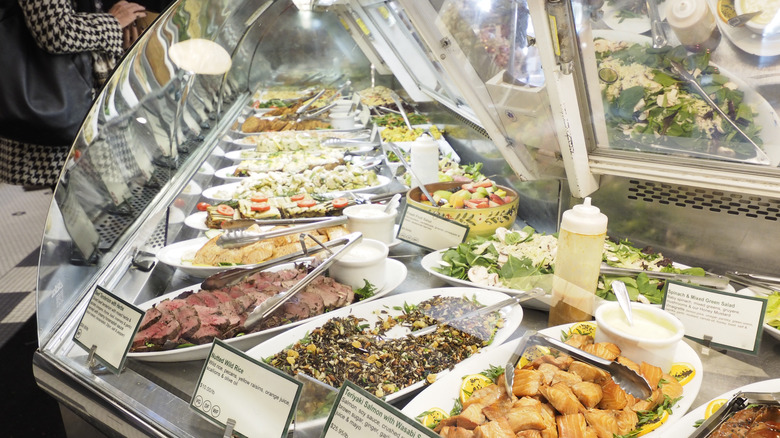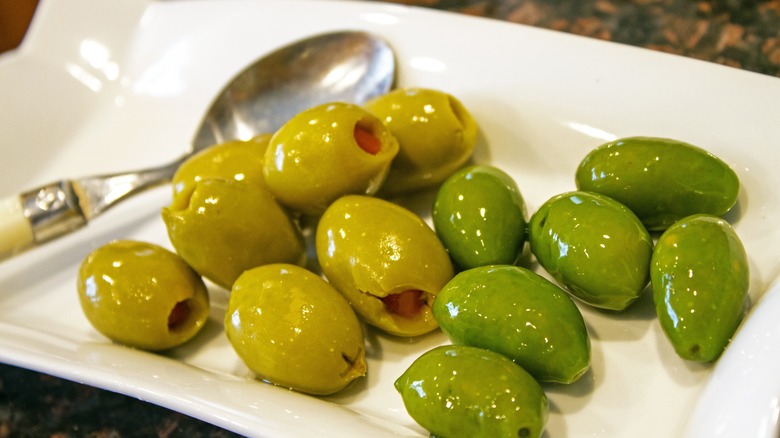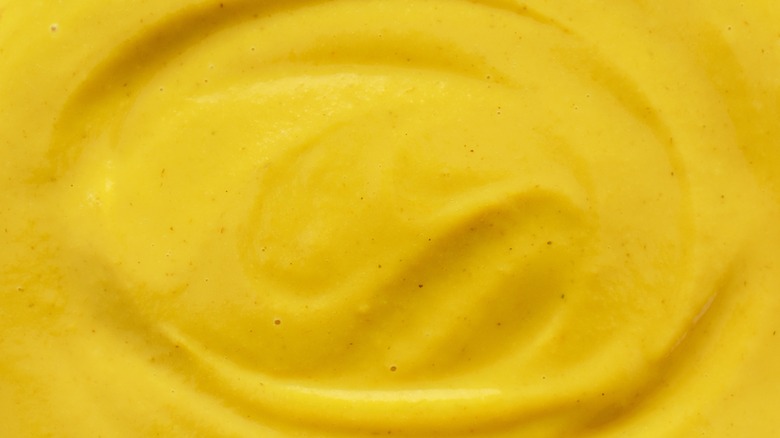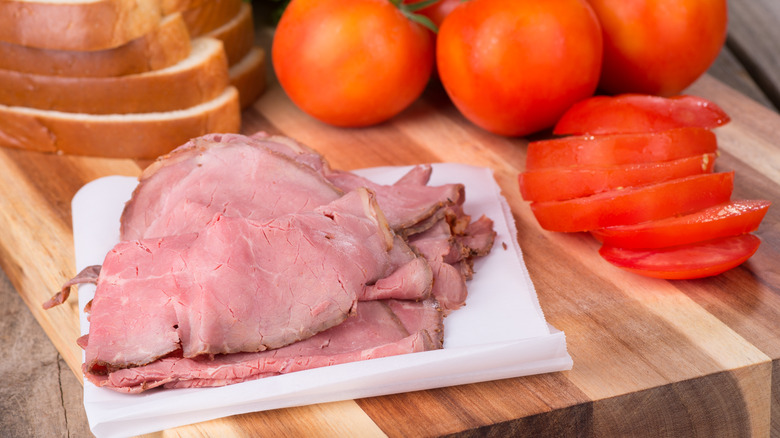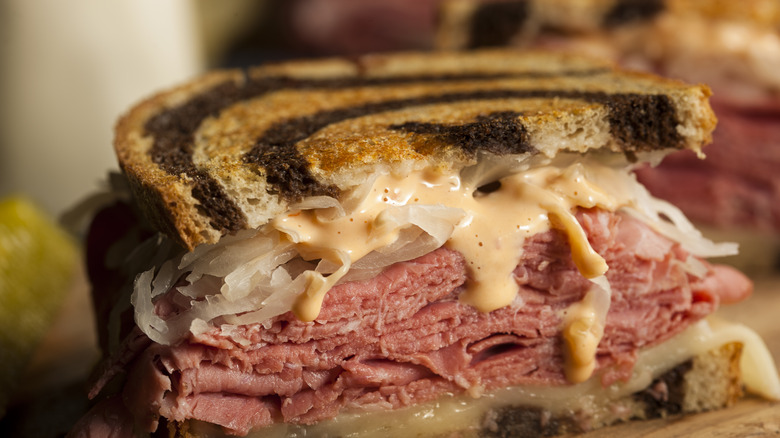11 Things You Should Think Twice About Ordering From A Deli
For most American diners, the word deli brings two very different images to mind. The first is the old-school Jewish delicatessen, with its mile-high pastrami sandwiches and menu of comfort-food favorites such as matzo ball soup and latkes. The second is the more-common supermarket deli counter, with its array of ready-to-go salads and hot dishes.
But no matter which type of deli you frequent, you need to be aware that not all deli food is created equal. Like most restaurants, both types have their strengths and weaknesses. So to know what to seek out and what to avoid, you should stick to what each type does best. The best Jewish delis are a celebration of a centuries-old food culture and the resourcefulness of 19th-century Eastern European immigrants, who adapted their traditional recipes to accommodate American ingredients.
The greatest supermarket delis are all about freshness: Nobody expects Michelin-star quality from their local Kroger or Publix, but you should expect food that's wholesome and attractive. I used different criteria to evaluate each of the two deli types and their offerings (I go further into methodology in the final paragraphs below). For Jewish delis, items to avoid are those that are incompatible with traditional deli culture. For supermarket delis, I used freshness, sanitation, and convenience as a metric — so items to avoid are those that fail to meet these standards.
White bread
Among the treats Jewish delis are famed for are their traditional breads — hearty versions of rye and pumpernickel, which you can enjoy in sandwiches or sometimes even buy as whole loaves to take home, as well as bagels and bialys. All of these specialties have deep roots in Jewish deli culture: For instance, Eastern European immigrants traditionally made their breads with rye flour, since rye grows more easily in the cold climates of Europe than did wheat.
For this reason, they didn't make plain white bread, even after immigrating to the United States, where wheat was more common than rye. So a good reason to avoid white bread in delis is to honor tradition. An even better reason, however, is that squishy white bread makes a pathetically unstable base for an overstuffed deli sandwich – one bite, and your pastrami or corned beef will be all over your plate (or worse, in your lap). But the best reason to avoid white bread in deli sandwiches is that tangy, chewy rye is a natural match for a peppery mound of pastrami and most other hearty deli sandwich fillings — why deny yourself that pleasure?
Soup of the day
At first glance, the idea of a soup of the day sounds pretty appealing. You may envision this soup as a special, one-time-only treat made with special seasonal ingredients. And in principle, it can be. In reality, however, it's more likely to be a hodgepodge of whatever ingredients that the kitchen needs to get rid of before they go bad. Of course, there's nothing wrong with avoiding food waste, and in the hands of a gifted cook, such a soup can be tasty. But if visits to a deli are a rare treat for you, you can do better.
And fear not, you have plenty of great options at a traditional deli if you find yourself in the mood for soup. An obvious choice is matzo ball soup, in which fluffy matzo balls soak up a flavorful chicken broth. Another is kreplach soup, the same rich broth studded with bite-sized meat-stuffed dumplings. If you feel like something heartier, try mushroom and barley soup — and if you want a splash of color and sweetness, borscht is another classic.
Hot foods over two hours old
You've just escaped from the office after a long and hectic workday, your family is at home waiting for dinner, and the last thing you want to do is cook. So you head to the deli counter of your favorite supermarket and zero in on the hot foods section in search of tonight's main course. With luck, it will still be hot when you get home, and everyone will be happy.
To ensure you deliver a satisfying meal, however, avoid the temptation to grab the first container of hot food you see — it may have been sitting under that hot lamp for two or more hours and be well past its prime. If you're thinking of a rotisserie chicken in a clamshell container, for instance, check the time stamp on the container, which stores are required to provide. If the chicken is more than two hours old and you have some time, you might consider waiting for them to be switched out for fresh chickens, which typically happens every two and a half hours.
Anything with mayonnaise
Aficionados of traditional deli food will tell you that some foods belong on the list of acceptable dishes and ingredients to enjoy in a deli and some don't. While Jewish deli food was historically shaped by kosher dietary laws, this is no longer the case in most delis — for instance, Reuben sandwiches clearly violate the traditional prohibition against mixing dairy and meat in the same meal, but have nevertheless become part of the deli menu canon. A common ingredient that doesn't make the cut in the Jewish deli tradition, however, is mayonnaise.
The reasons deli connoisseurs avoid mayo seem to be more about aesthetics and culinary tradition than kosher dietary law. Since mayo is technically pareve, meaning neither meat nor dairy, it should be legally allowable in any dish. But ask for mayo on your sandwich at a traditional deli, and your server will likely lose all respect for you. Katz's Deli in New York even warns its customers to "ask for mayo at your own peril." Yes, some delis will keep mayo on hand for picky eaters and for use in dishes such as egg salad and tuna salad, but you shouldn't be ordering these either: Why order something you can throw together at home when you have so many better options in front of you?
Salads served on non-delivery days
You've likely been to the supermarket and noticed the aisles clogged with pallets of food that staffers are busily unloading onto the shelves and into the display cases. The next time you encounter this, make a mental note of the day (or days) this occurs and store it away for future reference – it can be your key to a quality take-out deli meal, especially if you like to bring home salads and other dishes featuring fresh produce.
A straight line connects delivery days and the quality of your salad: A salad made from newly delivered produce is obviously going to taste and look fresher than that made from stuff that's been lying in storage for several days. So if possible, avoid choosing salad at the deli right before the delivery day, when the deli will be using up its oldest produce. If you're not sure when your deli gets its deliveries, just ask — cooks and managers will appreciate your inquiry and have no problem giving you the answer.
Bacon
Some delis have long menus, offering everything from blitzes to omelets to sandwiches and even chili. This could be because they want to cover their bases and ensure anyone who walks in can find something they'll enjoy. As a result, many have taken to serving items way outside the realm of traditional Jewish deli food — such as bacon, a blatant violation of the prohibition against pork in Jewish dietary law.
While few delis still keep kosher, some offer turkey bacon instead of regular bacon in a nod to tradition. But for many deli fans, even that hits wrong — bacon can be a wonderful thing, but like mayonnaise, it just doesn't fit into the deli tradition. Evan Bloom, co-owner of Wise Sons deli, told Grub Street that dining at a Jewish deli is a cultural experience. Even some diners who don't keep kosher themselves see bacon on a deli menu as a sign of un-seriousness.
Takeout fresh fruit cups
If health and fitness is your priority, consider bypassing the hot table loaded with fried chicken and mac and cheese in favor of the salad bar and fresh fruit at your supermarket deli. But use caution — sometimes, even the most healthful-looking items in the deli case can pose hidden risks. For instance, those plastic cups of melon cubes or pineapple spears may look healthy and refreshing, but they can also be vectors for food poisoning.
Cautious eaters should avoid pre-cut fruit from supermarket delis for the same reason we're warned against eating it when traveling to places with questionable water quality – it can easily pick up pathogens from the water and soil in which it was grown. The rinds of cantaloupes, for instance, can pick up listeria, E. coli, and salmonella bacteria from manure-enriched soil, and the textured surface of the rind can trap these pathogens, enabling them to persist through harvesting and shipping. Thus, if someone cuts open a cantaloupe without giving it a thorough wash first — a common mistake, even in commercial kitchens — they can inadvertently introduce these bugs into the edible part of the fruit. So to play it safe, buy whole fruit and invest the extra time to clean and cut it yourself.
Insufficiently warm or cold food
Savvy diners pay extra attention to the cleanliness of a restaurant or food shop before digging into its offerings — dirty tabletops, serving areas, and restrooms can be a sign of careless sanitation in the kitchen. As Anthony Bourdain notes in Kitchen Confidential, if a restaurant is okay with filth in the parts of a restaurant customers actually see, one can only imagine what horrors the management tolerates in the back of the house. But just as important for food safety in a deli is something you feel, rather than see: The temperature at which the food is held.
When you go to a supermarket deli, examine your choices carefully to make sure the hot food you select is actually hot and the cold food is, well, cold. What you want to avoid is perishable food in the temperature danger zone — between 40 and 140 degrees Fahrenheit – because this is the zone in which bacteria flourish. While it's fine to eat food in this zone if it hasn't been sitting around too long (most picnic and potluck food falls into this category), the risk of contamination rises the longer it stays out. So when you select your food at a deli, check the display cases and ensure the hot storage and refrigerated cases are in good working order. If food seems to be held at iffy temperatures, give it a pass.
Olive loaf
A big reason that supermarket delis are so appealing is their convenience — in principle, all you have to do is walk in, grab the ready-to-eat treats of your choice, and go. Of course, if you want counter service (for instance, to have sandwiches made or to order a custom cold cut platter) you might have to wait a bit longer. And among the root causes of time-sucking deli orders is an obscure meat you probably haven't thought about in years, if ever: olive loaf.
If you're not familiar with it, olive loaf is a processed meat somewhat like bologna, but studded with slices of pimiento-stuffed green olives. And according to deli workers, it's a pain to handle and slice. The olives tend to break apart when sliced, as does the meat itself, meaning deli workers often have to make multiple passes with the slicer to get an acceptable piece. And all those broken-up bits of olive and meat tend to fly out and stick to surrounding surfaces, meaning that the person behind the counter will have to stop slicing and clean everything up before serving the next customer. Don't be the person who makes everyone wait. Give the olive loaf a pass.
Yellow mustard
When you order a sandwich in a traditional Jewish deli, the default condiment is spicy brown mustard – its nose-tickling punch makes it a worthy match for assertively flavored deli meats and hearty rye bread. Many delis even formulate their own mustard blends, adding ingredients such as horseradish or garlic to add extra heat and flavor. It's a condiment with a long connection to Jewish history: Mustard is mentioned multiple times in Talmudic studies dating back to the 3rd to 6th centuries, although it's unclear exactly how the mustard of that era tasted.
While spicy brown mustard is a must in deli meals, many deli aficionados don't go for yellow mustard. It's unclear why, but a possible reason is its more mild, less-assertive flavor is not as good a match for deli meats as brown mustard, which is made from a hotter variety of mustard seed. So unless you find yourself in a deli in the Midwest, where yellow mustard does sometimes appear, don't bother asking for it.
Dull-looking roast beef
When choosing food at a supermarket deli, your first priority should be to seek out freshness. You want to avoid anything that looks like it's been sitting around a long time, so if the salad greens look a bit worse for wear or the rotisserie chicken a bit shriveled, stay clear of it. And no deli with such items out during peak business hours deserves your business — smart deli operators know to keep the fresh food in rotation during busy times.
This goes not just for steam table food and the salad bar — keep a close eye on the freshness of the food delivered from behind the counter as well. If you order a sandwich, for example, consider stale bread a warning about the quality of the rest of your meal. And check the meat — sliced roast beef should be moist and vibrant looking. If it looks dull, it's been pre-sliced and may have been lying around for a while. The same goes for other cold cuts – steer away from any that show discoloration, such as a gray or yellow tinge.
Methodology
I compiled these listings from my own personal (and professional) experience plus the wisdom deli and food service insiders have shared online. As a former professional pastry cook, I trained in food safety and sanitation practices and developed a superior eye for questionable deli food. The items on my hit list are those I'd avoid buying as a customer.
As a proud third-generation Chinese American, I also grew up immersed in Jewish deli culture. My mom had a summer college gig waitressing in a Jewish resort in the Catskills, where she picked up a lifelong fondness for traditional deli food. I learned that there was a big difference between real delis and sandwich joints that call themselves delis. To confirm my suspicions about what is and isn't part of a traditional deli experience — and the items you should think twice about ordering — I also turned to blogs and cultural publications.

